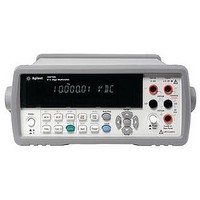34410A AGILENT TECHNOLOGIES, 34410A Datasheet - Page 6

34410A
Manufacturer Part Number
34410A
Description
MULTIMETER, DIGITAL, BENCH, 6-1/2 DIGIT
Manufacturer
AGILENT TECHNOLOGIES
Datasheet
1.34410A.pdf
(20 pages)
Specifications of 34410A
Dmm Type
Bench
Voltage Measuring Range Dc
100mV To 1000V
Voltage Measuring Range Ac
100mV To 750V
Current Measuring Range Dc
100µA To 3A
Current Measuring Range Ac
100µA To 3A
Lead Free Status / RoHS Status
na
Precision DCV measurements
combined with peak measurements
Power supplies often have
ripple voltages that are riding
on top of the desired DC output.
These ripple voltages are speci-
fied and tested to be a certain
level or less. Frequencies of the
AC signal are often power-line
related, but they can be associ-
ated with higher-frequency
byproducts of switching power
supplies. For example, Figure 1
shows a DC signal with an
AC component.
A common approach to this
measurement problem is to
make both a DCV and ACV
RMS measurement. However,
there are limitations to this
approach:
• Making two measurements
• A typical ACV RMS measure-
• Having to digitize to get peak
takes more time – especially
changing function and range.
ment lacks valuable peak
information.
information takes time.
Figure 1. A 5 V DC signal with an AC signal
The 34410A and 34411A
DMMs provide a secondary
measurement function called
peak measurements that you
can activate when you make
precision DCV (or ACV)
measurements. Here is an
improvement on the above
approach:
• Enable the peak measure-
• Make a precision DCV
• The DCV and peak measure-
Peak measurements occur at
20-µs intervals during the
aperture of the DCV measure-
ment, so any peak that is at
least 20 µs wide can be detected.
5 V
ment function.
measurement using 1 or
more periods of power-line
cycle integration time to
reject power line frequencies
and random noise.
ment data is displayed.
DC
6
Several scenarios that can be
determined from the two mea-
surements:
1. The DCV and peak-to-peak
2. The DCV is correct, but the
3. The DCV is slightly off,
In cases 2 and 3, the peak-to-peak
ripple voltage is in question.
Case 2 may be excessive noise
spikes due to failed output
filtering. Case 3 could be
distortion that is creating an
asymmetrical AC component
that adds a DC component
to the DCV measurement. In
that case, the ripple may retain
the same peak-to-peak voltage.
When the primary measurement
fails, more information about
the signal is required. The
34411A DMM provides wave-
form capture at 50 k readings/s
that can sample the signal to
provide additional diagnostic
information.
data are within tolerance –
passed
peak-to-peak value exceeds
a limit – failed
but the peak-to-peak value
is OK – failed










